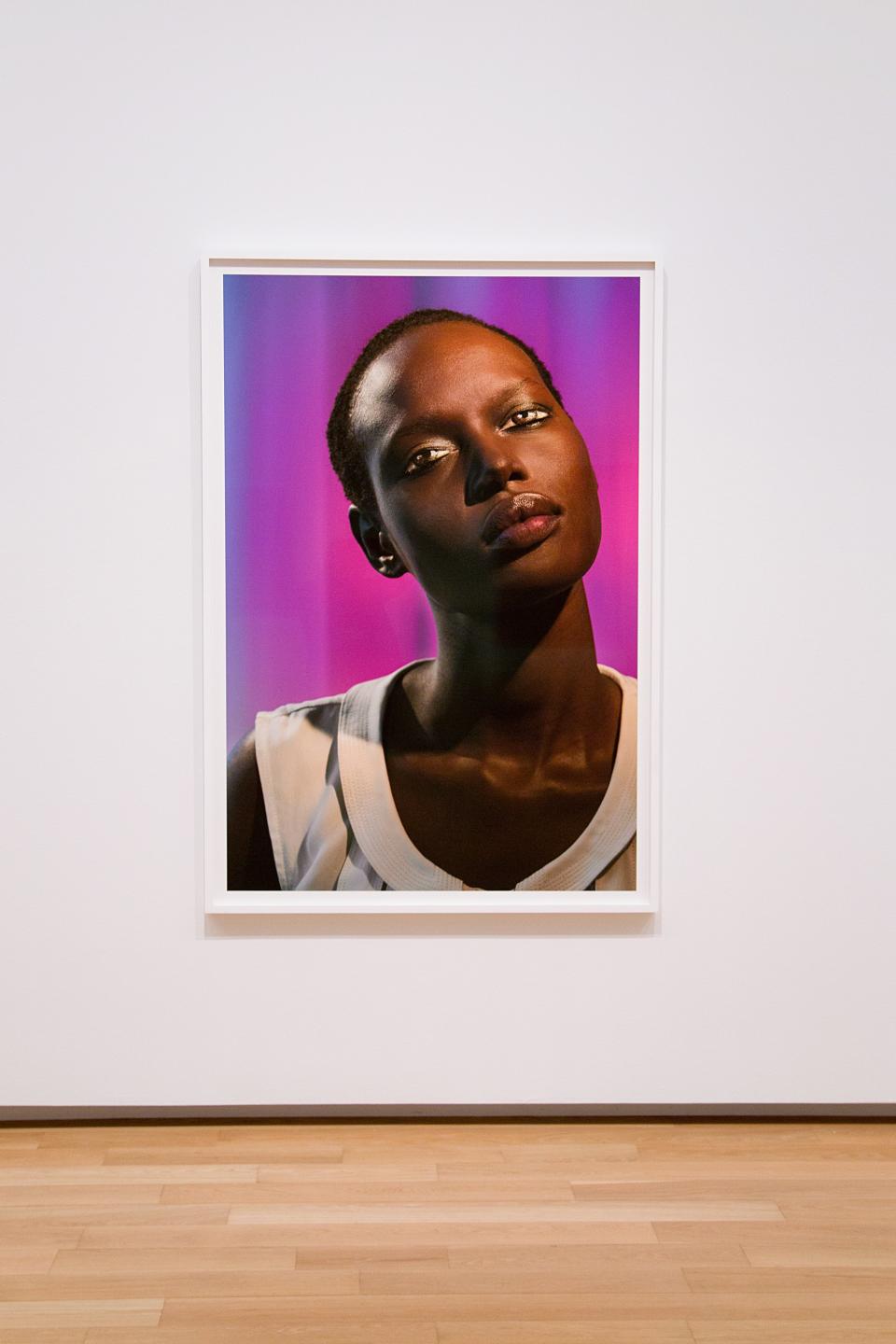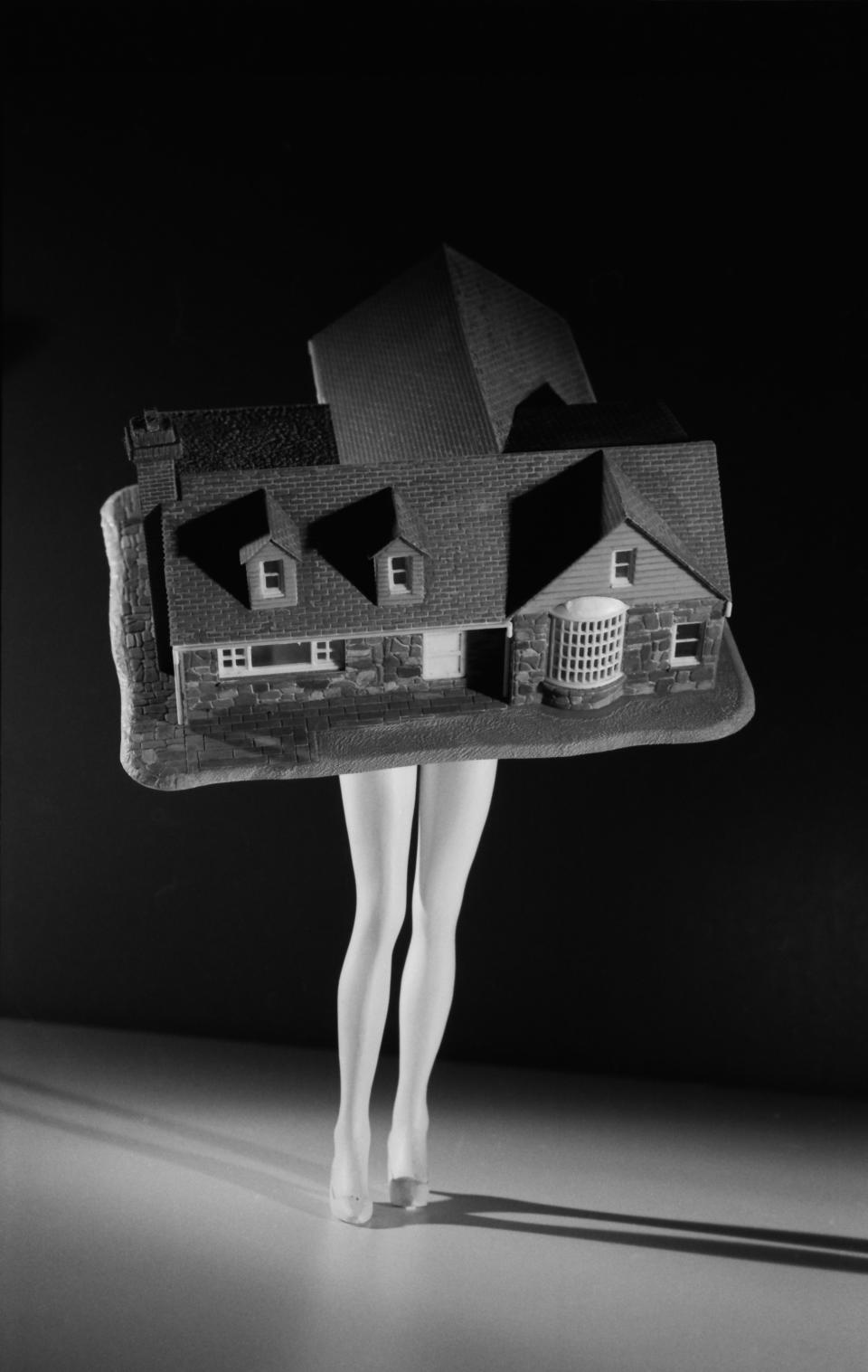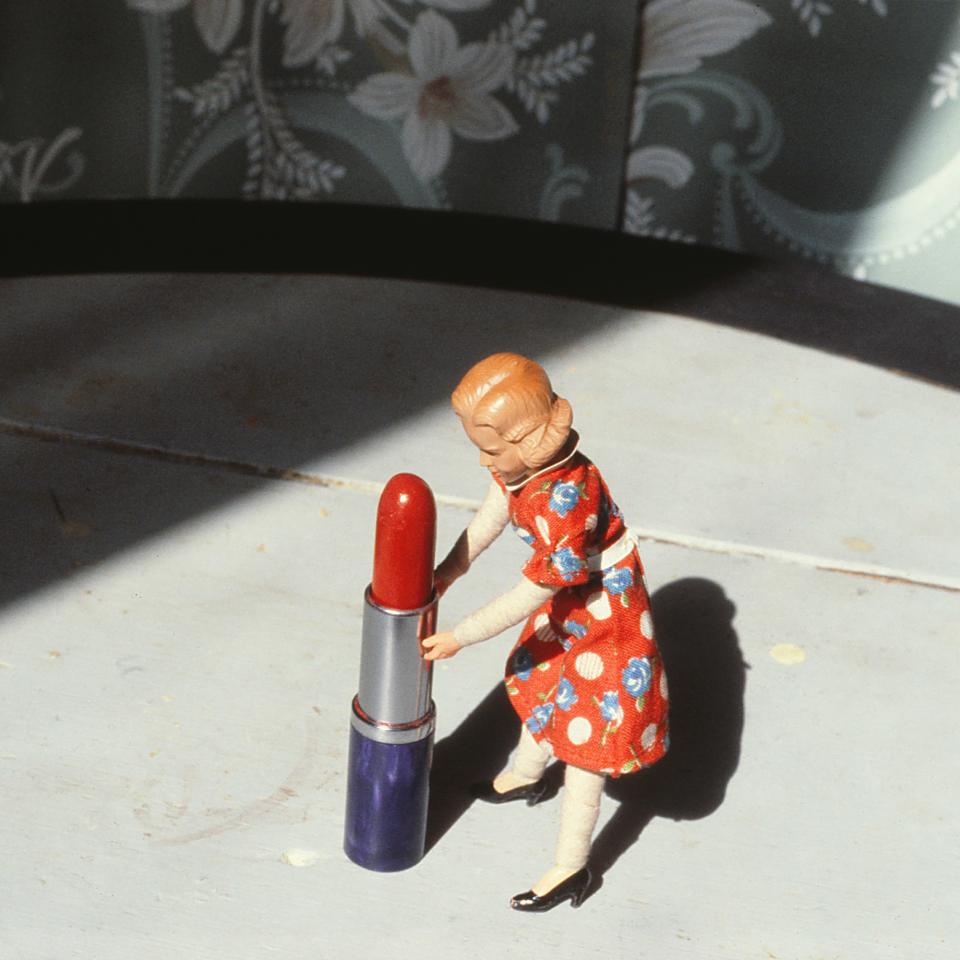Artist Laurie Simmons Just Made Her First Wearable Artwork: A Bold Red Lipstick
Long before Lena Dunham put “Grow armpit hair” at the top of her 2015 summer to-do list, her mother, artist Laurie Simmons, was reevaluating her own grooming habits at an upstate New York commune. It was the dawn of the ’70s, and “this was my early feminist awakening,” Simmons says, recalling a wardrobe of “tattered or embroidered blue jeans, work boots, and flannel shirts. I really was not shaving [my] legs, not wearing makeup.” When the Long Island native returned to Manhattan a couple years later, she caught up with friends who “hadn’t had that same, let’s call it, ‘hippie experience.’ I was kind of shocked to see that beauty and makeup and dressing up were still very relevant,” she says. “So I dove back in.”
As cosmetics such as lipstick became an everyday staple for the artist, it also edged into her photography. In a 1979 color series called Pushing Lipstick—featured in Simmons’s new retrospective, “Big Camera/Little Camera,” at the Modern Art Museum of Fort Worth—a miniature female doll confronts a life-size tube. The scene calls up a raft of associations: artifice and reality, gender roles and phallus objects, an ideal of glamour too big to shoulder. Still another possible reaction: Where can I find that perfect shade of poppy red?
Now there’s an answer: right inside the museum shop. For her first wearable artwork—a limited-edition lipstick called Pushing It—Simmons has teamed up with Poppy King, the Australia-born beauty veteran behind Lipstick Queen. (Having sold the niche line in 2011, King went out on her own last year and is now working on her forthcoming makeup project, Femme de Poppy.) Connected by a mutual friend in the run-up to the exhibition, the two women instantly sensed a kinship. “It was like the best kind of lipstick Tinder date you’ve ever had,” King says with a laugh. She unearthed one of her archived formulas—semi-sheer, with a “kind of airiness to it”—that evokes the fiery namesake flower. A run of 50 ($50) is available in Fort Worth; another 50 will travel with the show to the Museum of Contemporary Art Chicago in 2019.
“I like to say I needed more lipstick in my life, and she needed more art,” says Simmons of their plan to hatch more lipsticks. In the meantime, the artist talks about her unconventional lessons in color theory, why she finally embraced neutral lip colors, and how the Internet’s hyper-real language of beauty is shaping perception.

In reviewing decades of work for your retrospective, is there a series that feels newly ripe for this moment?
One is a series called Fake Fashion that I made in 1985. They’re sort of structured like fashion photographs—the poses and models, et cetera—but at the time I used very inexpensive polyester clothing from the stores on Broadway, where I lived, so there was no real focus. We’re not advertising a shirt or a necklace or makeup. They’re just fake. My favorite [part of the exhibition] is my most recent work. It’s a series called How We See, in which models have their eyelids painted [like realistic eyes].
Was there ever a point when you questioned whether these subjects—makeup, fashion—were serious enough?
I’ve always had a very unapologetic interest in fashion. In fact, there was a point in my childhood when, even though I loved to draw and paint, I just always assumed I would go into fashion, because there was no hierarchy of art in our household. Making a fashion illustration was no different than painting the Mona Lisa to my parents. They just saw it all as art. I’ve always preached the value of the crossover in art, and as I’ve gotten older, people are more and more comfortable with that crossover. There’s an assumption now that it’s okay.
Tell me about the making of Pushing Lipstick.
The thing that marks that series as significant to me is that it’s the only early series where I ever broke scale. The idea of putting a life-size anything in any of my small-scale photographs was absolutely verboten in my work. I was very secretive about those pictures, because we artists, we make our rules and then we break our rules.
What made you bring the lipstick into the frame?
There were so many things around my studio, and I would sort of intuitively pull things into a picture. The doll had a bright red dress and a kind of aggressive stance. I just grabbed this lipstick and put it in front of her as though she were holding it or embracing it. I was quite simply intrigued by what I saw through the camera, and so I kept shooting it over the course of a few days or weeks. But it was like a secret project. Back then, the initial entry point was always formal: color, composition. But there is something that I see now that is a bit ominous about a woman being able to embrace a life-size version of a beauty product. As much as I sometimes wish there wasn’t, there’s a dark side to everything I make.

Was lipstick always a part of your look?
Lipstick has been very significant to me in my life. I wore a lot of makeup in high school. In fact, I always say that I learned all my color theory from lipstick and nail polish. If we were getting our shoes dyed to match our dresses and someone forgot their swatch, I was always the one that could figure out the color. I had a great color memory and a great sense of reds and pinks. I learned it all through makeup! Much like my mother, I felt that if I went out without lipstick, I was naked. But in those days, lipstick, to me, was either red, orange, fuchsia, or coral—four colors.
After coming back from the commune, was there any blowback when you started wearing makeup again?
No, I think it depended who your friend group was. I didn’t feel judged, and I felt like it was important not to be judged. I was so conscious, even then, of the horror of women being accused of looking provocative—that women did not have to take responsibility for what men did to them based on the makeup they wore, the clothing they wore. The politics of beauty revealed itself to me at a very young age. I could see it. Maybe it’s because I grew in a so-called perfect post–World War II suburb. There wasn’t much else beyond the way you presented yourself. Everything was located in appearance.
What surprised you most about working with Poppy on the lipstick?
It’s amazing to meet someone and think you’ve found a collaborator. We want this to be the first of many projects together. Poppy is highly evolved in her views about beauty and politics, and at this point—having been firmly, squarely rooted in the center of the beauty business—she can let her fantasies soar. We started with the ultimate iconic lipstick color, a poppy red, which is also Poppy’s name. As far as I’m concerned, this is a color that looks great on every woman, every skin tone, every hair color—but that’s just me.
What’s your own personal lipstick collection like—variations on red?
I have an arsenal of those, and I wore Poppy to the opening. But the thing about aging is you have to respect your face and your body. It kind of tells you what to do. As I got older, I was drawn more to lipstick colors that were the same as my lips, and it seemed like a really big surprise, because I have all these great reds and fuchsias and dark colors. Now there are neutral tones that I love that I never thought I would wear.
Writing for Vogue, Lena often weaves in your views on beauty, including your description of red lipstick as “a cosmetic enhancer as well as a disguise, an art project, a photo op, a suit of armor, an invitation, and a do-not-disturb sign.” Do you see your work dovetailing with hers?
I do. My subject has always been women in interior spaces: their stories, the way they look, what they see, the way they act. And I feel like Lena just went at it the same way I did, like a dog with a bone, trying to portray the truth from her vantage point. I see myself as an image maker, and sometimes it seems like there are sort of Easter eggs or gifts to me in her work—like a wedding party where I could see little cakes on legs. We both like making pictures of cakes! They’re just things we like to look at.


